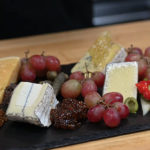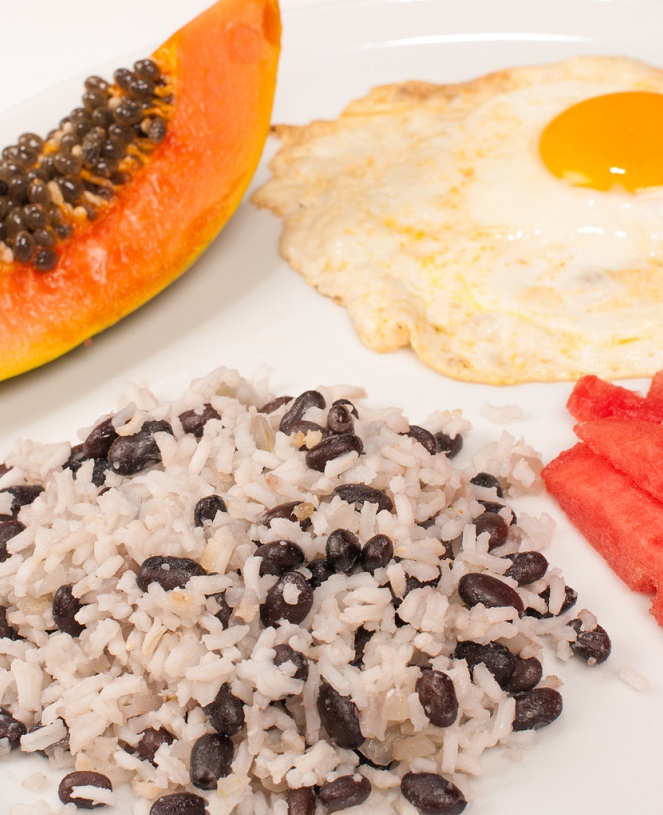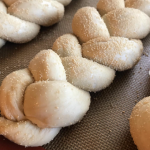Known for its political stability and high standard of living, Costa Rica sits at the intersection of three geographic areas: Mexico and Central America, South America, and the Caribbean. Its cuisine has transformed over time as different cultural groups have arrived and blended their flavors and ingredients to create new tastes. As a result, there are three general cultural sections: the Afro-Caribbean Atlantic coast; Guanacaste in the northwest, one of Costa Rica’s most popular tourist destinations; and the Hispanic-influenced Central Valley, where about 70% of the population lives.
The multiculturalism of the Atlantic coast merges indigenous, African, Caribbean, European, and Asian influences. Coconut milk features in many of the dishes there, along with fruits like plantains and spices brought to the region by traders like ginger, curry, thyme, allspice, and cinnamon. Fish, shrimp, lobster, and other types of seafood are also very popular on the coast, as well as throughout the rest of the country.
In Guanacaste, recipes that contain corn are very popular; this is different than the rest of the country since most Costa Ricans don’t focus their diets on maize-based foods. Dishes common in Guanacaste include tortillas, empanadas (turnovers), arepas (cornmeal cakes), chorreadas (pancakes), rosquillas (doughnuts), corn rice, and tamales steamed in plantain leaves.
The Central Valley is home to San Jose, the country’s capital, and combines urban areas with valleys, rivers, hills, mountains, and volcanoes. The food of this region is generally based on meats, fresh vegetables, and herbs. There’s also a variety of international restaurants in the metropolitan zones.
Overall, Costa Rican food tends to not be as spicy as many of the other cuisines across Central America. It instead focuses on the more savory side of aromatics, highlighting tastes like cilantro, oregano, sweet red peppers, onions, and garlic.
The Diet and Popular Dishes
While Costa Rica’s early cuisine came from the surrounding indigenous populations — including beans, tortillas, tamales, squash, potatoes, and yuca — the Spanish conquest introduced rice to the region, which wasn’t a native food in the Americas. Today, rice and beans is one of the principal meals in Costa Rica, often served for breakfast, lunch, and dinner. The Costa Rican diet relies heavily on this rice-and-beans combination, along with meats, eggs, cheeses, fruits, and vegetables.
Costa Rica’s national dish is gallo pinto, which translates to “spotted rooster.” It consists of rice and beans cooked together to create a speckled appearance, and there are variations of the dish depending on the region.
In the Central Valley, they include plenty of oil to make the rice-beans mixture moister. In Guanacaste, on the other hand, the gallo pinto is often more toasted and can also have fried plantains, white cheese, or cooked chicken or beef. On the Atlantic coast, the rice is frequently prepared with coconut milk instead of water, and the dish tends to favor the rice over the beans, which is different from other variations in the country. The pimienta roja (locally grown spicy red pepper) gives the coastal gallo pinto a flavorful kick.
Meal Practices and Eating Traditions
Meals in Costa Rica can seem repetitive, but there are differences. Breakfast tends to be on the heavier side, with gallo pinto accompanied by fried or scrambled eggs, as well as fried sausage or bologna, salty cheese, tortillas or toast, fried plantains, and fresh fruit.
Most meals in Costa Rica happen at home, including lunch. Lunches cooked at home revolve around a plate of rice prepared that morning, with sweet red peppers, yellow onions, cilantro, and garlic. Some other popular entrées include sopa negra (broth with beans and a hardboiled egg); olla de carne (stewed beef on the bone with vegetables like corn, carrots, plantains, and chayote); picadillos (cooked vegetables and meats stewed together in a hash); and rice with chicken.
At dinner, the foods are usually the same as those served at lunch, sometimes with a freshly prepared side dish like patacones (friend green plantains). Desserts don’t often follow meals directly but are instead served with cafecito — a quiet time between lunch and dinner where Costa Ricans enjoy fresh coffee — or as snacks.
Fun Fact
The simple Costa Rican diet is generally considered quite nutritious and balanced, and Nicoya — a small, rural beach community on the Guanacaste peninsula — is even one of the longest-living communities in the world.
Sample one of the most popular dishes in Costa Rica by following the recipe below:
Gallo Pinto (Costa Rican Black Beans and Rice)
Servings: 6
1 ¾ cups dry, long-grain brown rice 1 teaspoon tamarind concentrate 1 ¼ cups water (for the rice) ⅛ teaspoon ground cumin ¼ teaspoon salt ⅛ teaspoon ground coriander seed ¾ cup dry black beans ⅛ teaspoon ground ginger 1 tablespoon vegetable oil ½ tablespoon green onions, chopped ¼ cup onions, diced ½ tablespoon fresh cilantro, chopped ⅛ teaspoon fresh garlic cloves, peeled and minced
STEP 1: To prepare the brown rice, bring the water with salt to a boil. Add rice and stir. Reduce heat to the lowest setting, cover, and cook for about 35 minutes or until all the water is absorbed. Let stand, covered, for 10 minutes and then uncovered for another 10 minutes.
STEP 2: To prepare the black beans, rinse and sort through the beans to remove pebbles or other debris. If desired, soak the beans in water overnight. Place in a stock pot and cover with water by 2 inches. Bring to a boil. Lower heat and simmer the beans for approximately 1 hour, adding water as needed to keep the beans covered. Continue to cook until the proper texture is achieved.
STEP 3: Heat vegetable oil in a large pan over medium heat, and sauté onions until they start to soften.
STEP 4: Stir in garlic, tamarind concentrate, ground cumin, ground coriander seed, and ground ginger. Continue to cook for about 5 minutes.
STEP 5: Add rice and beans. Cook until the proper temperature is reached.
STEP 6: Garnish with fresh cilantro and green onions.







